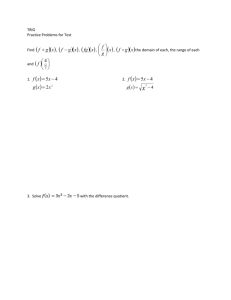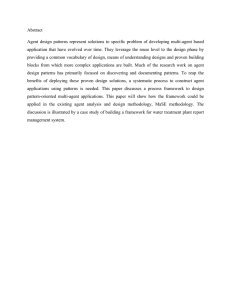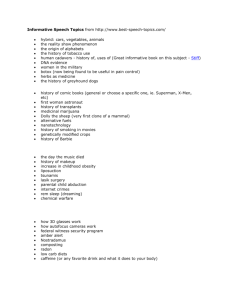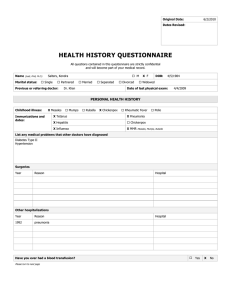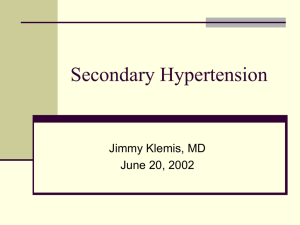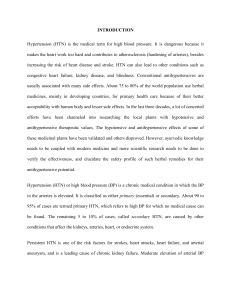IMPACT Multi-Agent Planning Research
advertisement
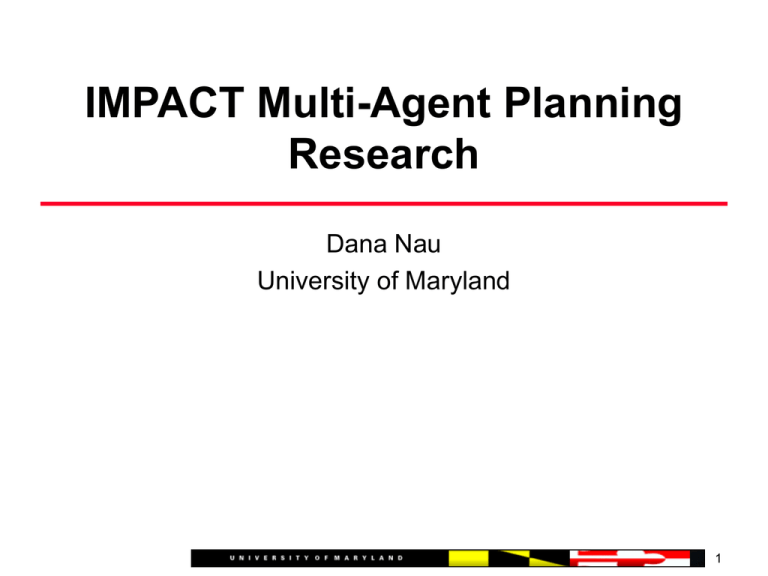
IMPACT Multi-Agent Planning
Research
Dana Nau
University of Maryland
1
Motivation: Noncombatant
Evacuation Operations (NEOs)
Goal: assist DOS to evacuate people
whose lives are in danger
noncombatants
nonessential military personnel
host-nation citizens
third country nationals
Characteristics:
Joint task force
– geographically distributed
– often multinational
Uncertainty; complexity (200+ tasks)
US Ambassador is senior authority
1999 IMPACT Workshop
2
Difficulties with NEOs
Multi-agent planning
Supplies are not centralized
Planning is the responsibility of the geographic commanders
Resources: Doctrine, Exercises, DOS, EAP, etc.
Information about supplies is not centralized either
Potential for conflicts among simultaneous operations
Example (not a NEO): moving Apache helicopters from
Ramstein to Albania during the Kosovo crisis
1999 IMPACT Workshop
3
Key Technologies
Access to distributed,heterogeneous
data sources
Seamless interoperability between
different software capabilities
Ability to coordinate multiple agents
Scalable, high performance planning
systems
create plans
interact with the above data and software
sources
Already being
developed in
the IMPACT
project
To be added
to IMPACT
1999 IMPACT Workshop
4
What Planning Is
Generate sequences of actions to perform tasks and
achieve objectives
Driving force
The need for ways to aid human planning
Example application areas
military operations and logistics
design and manufacturing
space exploration
1999 IMPACT Workshop
5
Limitations of Classical Planning
Classical planning theory:
Either purely symbolic (AI
planning) or purely numeric
(OR planning)
Single agent (the planner)
Perfect information
No interaction with users
What’s needed in practice:
Mixed symbolic & numeric
computation
Multiple agents
Imperfect information, external
information sources
Human user in control of
planning
The above limitations may be overcome using a mix
of IMPACT and scalable planning algorithms
1999 IMPACT Workshop
6
Approach
Extend IMPACT to include
(1) planning actions
(2) temporal constraints for plans
(3) complex planning tasks
1999 IMPACT Workshop
7
(1) Planning Actions
Extend IMPACT rules so that heads of rules contain
planning actions
Example:
if an item’s current inventory level has dropped below its
restocking threshold, then create a plan to restock it at its stock
level, by a given date, and within the given budget
DO build-plan(restock(‘widget-25’,X.rstocklev,8/30/99,100k))
<= in(X,oracle:select(‘inventory”,item,=,‘widget-25’)) &
<(X.qty,X.threshold).
Problem:
semantics of agent programs forces all executed actions to have
a well-defined add/del list
build-plan(…) may or may not be achievable, so we don’t know
what the add/del list should be
1999 IMPACT Workshop
8
Planning Actions (Contd.)
Extend IMPACT rule syntax to allow heads of rules to:
contain a planning action and
support actions whose outcomes may involve “conditional”
add/delete lists of the form “fail” or “add/delete <specified lists>”.
Extend the IMPACT implementation to support
invocation of such planning actions
1999 IMPACT Workshop
9
(2) Temporal Constraints for Plans
A tcass (temporallyconstrained action status set)
is a set of action status atoms
with temporal constraints on
the actions
Example:
< {a1,a2,a3},
{ st(a1) = st(a2),
et(a1) < et(a2),
st(a3) - st(a2) < 5,
et(a3) - et(a2) < 3
} >
where
st(a) denotes a’s start time
et(a) denotes a’s end time
Increase the expressive power
of agent rules by allowing rules
of the form:
Op tcass <= Body
Also allow replacing tcass by
a call to a planner which
generates a tcass as its output
We plan to refine the syntax
and study
semantics of such programs
sound/complete status-set
computation algorithms
implementation techniques
and experiments
applications such as NEO
planning
1999 IMPACT Workshop
1
(3) Complex Tasks
Extend agent program rules so that the head of an agent
program rule can have the form
Op htn <= Body
where htn is either
an HTN (a hierarchical task network)
– (see next slide)
a call to an HTN generation program
– e.g., the SHOP planning system (described later)
We plan to refine the syntax and study the
semantics
computation algorithms for feasible status sets
implementation and experiments
applications
1999 IMPACT Workshop
1
HTN Planning: An Example
Select Helicopter Launching Base
Establish Base
within Flying
Distance
alternative Launch from
methods Carrier Battle
Transport helicopters
available (H)
Security force
available (F)
Group
Transport helicopters
available (H)
Helicopters have air
refuel. capability (H)
Select Helicopter Launching Base
Select possible area (A)
Transport sec. force (F,A,H)
Embark sec. force (F,H)
Fly(H,A)
Disembark (F,H,A)
Position security force (F,A)
Transport fuel to (A)
...
Decompose
tasks into (more tactical) subtasks
Consider restrictions (e.g., transport helicopters available)
Resolve interactions (e.g., deploy security force first)
If necessary, backtrack and try other methods
1999 IMPACT Workshop
1
Leverage (1)
SHOP - Simple Hierarchical Ordered Planner
New HTN planning system [Nau et al., IJCAI-99]
Outgrowth of some of the ideas explored in the Bridge Baron
Sound and complete over a large class of planning problems
Much more expressivity than most other planning systems
– Mixed symbolic & numeric computations
– External information sources
Solves standard benchmark problems orders of magnitude faster
than other domain-independent planning systems
Complete implementation in Common Lisp
– Available via FTP; downloaded by dozens of researchers
Implementation in Java underway
1999 IMPACT Workshop
1
Leverage (2)
HICAP: Non-Combatant Evacuation Planning
Joint ongoing work with the Naval Research Laboratory
Combines SHOP with case-based reasoning
– Makes use of military doctrine and previous successful plans
Nominated for best-paper award at ICCBR-99
Héctor Muñoz will demo HICAP during the demo session
1999 IMPACT Workshop
1
Multi-Agent Planning
We intend to do the following
Incorporate the extensions mentioned earlier
– planning actions
– temporal constraints for plans
– complex planning tasks
Develop protocols by which multiple agents may coordinate
planning activities with one another
Derive results showing that (under certain conditions to be
determined), such protocols guarantee convergence on a plan
– This will ensure termination within predictable running times
Develop applications
– TBD, but a likely possibility is multi-agent planning for NEOs
1999 IMPACT Workshop
1
